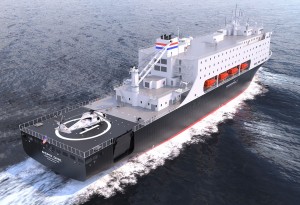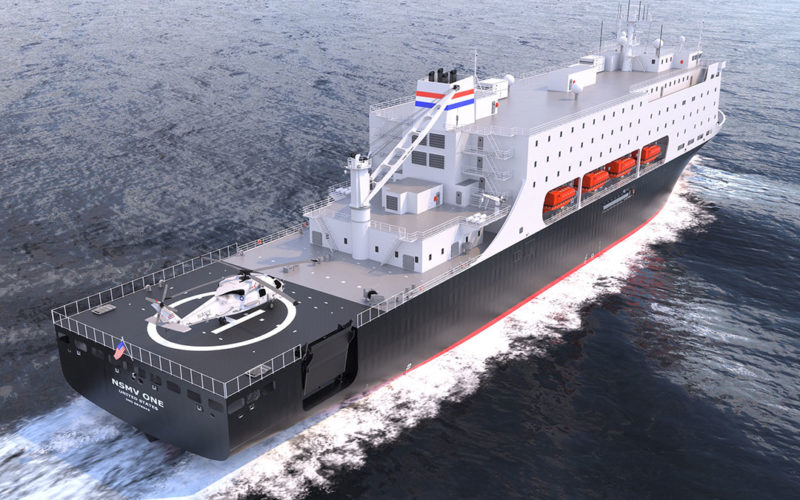
Maritime at Galveston will receive the third and fourth national security multi-mission
vessels from Philly Shipyard. Delivery of the first ship in the series, for SUNY Maritime, is slated for early 2023.
When alumni return to Maine Maritime Academy in Castine, Maine, they’re not drawn to the docks or the football stadium. Instead, they gather around the scale models of previous training ships that the school has used to prepare cadets for their careers at sea.
“Whenever we have functions that bring in alumni, you can hear them telling their kids, ‘That’s the ship I sailed on,’ and their careers were built around their experience on board these various training ships,” said Dr. William J. Brennan, president of the academy and chairman of the Consortium of State Maritime Academies.
The group was the driving force behind getting approval in 2019 from the U.S. Maritime Administration (MarAd) to build five national security multi-mission vessels (NSMVs) for the country’s maritime academies. In January, MarAd authorized the construction of two more ships in the series, for Maine Maritime and Texas A&M Maritime, bringing to four the number of vessels officially in the works. The first steel for hull No. 1 was cut at Philly Shipyard in December.
“To think we were so successful in getting this program stood up is a testament to the consortium,” Brennan said. “I wasn’t particularly sanguine about the prospects because it’s a relatively insignificant program in the federal government.”
As the saying goes, it helps to have friends in high places, and Brennan spent years on Capitol Hill in various capacities. Being from Maine, he became friendly with Sen. Susan Collins, R-Maine, when the two were congressional staffers early in her career. Now a senior senator, she chaired the Senate appropriations subcommittee on transportation when the NSMV discussions started.
“It was Sen. Collins who made this happen over time and it was fortuitous that she was the chairman of the appropriations (subcommittee),” Brennan said.
The NSMV process began nearly a decade ago. The training ship for SUNY Maritime Academy, Empire State VI, was approaching 60 years old and needed to be replaced.
Brennan coordinated the efforts of all of the maritime academy presidents and got the ball rolling in Washington. The biggest challenge was to make politicians understand the importance of the schools and the value of the training ships.
The NSMVs will be owned by MarAd. Funding has been allocated for four ships, with construction manager TOTE Services retaining an option for a fifth vessel. SUNY Maritime will receive the first NSMV, followed by Massachusetts Maritime, Maine Maritime, Texas A&M Maritime and the California State University Maritime Academy. Delivery of the first NSMV is scheduled for early 2023. The total contract value of the five-ship program is estimated at $1.5 billion.
Capt. John Cashman, commandant at Maine Maritime, said the ship replacing the 31-year-old State of Maine will enable the school to expand its programs. For example, each NSMV will have a training bridge in addition to a live bridge.
“To be able to train students on the systems they’ll encounter when they’re in the fleets is huge,” Cashman said, adding that students training for land-based operations will benefit as well. “If you’re working shoreside logistics and the engineer is sending back a message on a part that’s delaying a cruise, you have a better understanding.”
NSMV at a glance
Dimensions
• Length: 524’ 1”
• Beam: 88’ 7”
• Depth: 55’ 1.5”
• Design draft: 21’ 4”
Propulsion
• Four 3,900-kW diesel-electric main engines divided between two engine rooms
• Total installed power: 15,700 kW
• Full speed: 18 knots (four engines)
• Cruising speed: 12 knots with two main engines in one engine room • Range: 11,000-plus miles at 18 knots
Maneuverability
• Azimuthing bow thruster for “take home” power
• Stern thruster
• Flap-type rudder
Accommodations
• Training ship mode: 600 cadets, 100 officers, faculty, staff and crew
• Surge capacity for humanitarian assistance/disaster response missions
• Food storage for 60 days
• Freshwater storage for 14 days
U.S. Maritime Administration

